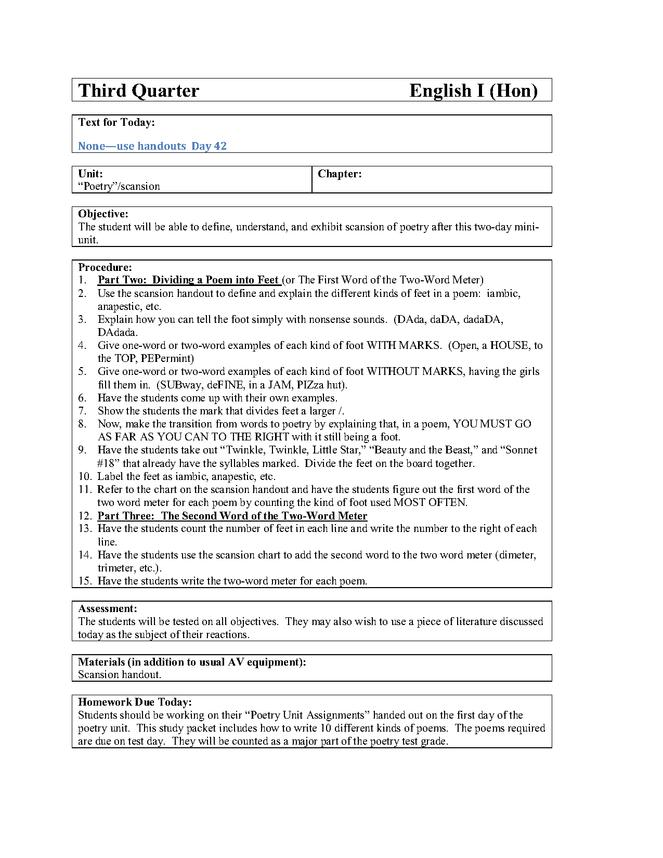


The rhythm of language is infinitely varied all aspects of language contribute to it: loudness, pitch, duration, pause, syntax, repeated elements, length of phrases, frequency of polysyllabic words. There is even a debate among scholars as to what systems were inherited from the Greek and Roman poetry.To understand any form of scansion, it is necessary to appreciate the difference between meter and rhythm. Systems of scansion, and the assumptions (often tacit or even subconscious) that underlie them, are so numerous and contradictory that it is often difficult to tell whether differences in scansion indicate opposed metrical theories, conflicting understandings of a line's linguistic character, divergent practical goals, or whether they merely constitute a trivial argument over who has the "better ear" for verse. Over the years, many systems have been established to mark the scansion of a poem. In both cases, the meter often has a regular foot. In English poetry, they are based on the different levels of stress placed on each syllable. In classical poetry, these patterns are quantitative based on the different lengths of each syllable. Yeats.Scansion ( SKAN-shən, rhymes with mansion verb: to scan), or a system of scansion, is the method or practice of determining and (usually) graphically representing the metrical pattern of a line of verse. Eliot, Alice Oswald, Wallace Stevens, and W. Other examples of iambic meter in poetry include “ Paradise Lost, Book VI, Lines 801–66” by John Milton, “ Essay on Man, Epistle I ” by Alexander Pope, “ ” by William Wordsworth, “ The Face of All the World (Sonnet 7)” by Elizabeth Barrett Browning, as well as works by T. **The line begins with a trochee, and a stressed syllable ends the line, which is known as a “masculine ending.” *With the eleventh syllable as unstressed at the end of the line is known as a “feminine ending.” Sky of Spring rains, it’s the greening of the trees ** Their cotton candy- colored blossoms to the slate Of the crab apple tree, more than the neighbor’s*Īl most ob scene dis play of cherry limbs sho ving More than the fuchsia funnels breaking out For instance, the scansion of the poem “ Instructions on Not Giving Up” by Ada Limón reveals that the first four lines are in iambic pentameter before a change in the fifth line: Which by and by black night doth take a way,ĭeath's second self, that seals up all in rest…Ĭontemporary examples of iambic pentameter in poetry tend to be interwoven with other iambic and varied forms of meter within the poem, including sonnets. In me thou see’st the twilight of such day Up on those boughs which shake a gainst the cold,īare ruined choirs, where late the sweet birds sang. When yellow leaves, or none, or few, do hang That time of year thou mayst in me be hold For instance, “ That time of year thou mayst in me behold (Sonnet 73)” indicates the use of iambic meter with every stressed syllable in bold with the following scansion: William Shakespeare famously wrote his plays and sonnets in iambic pentamer. John Milton used iambic pentamer in his epic poem Paradise Lost (1667) and William Wordsworth also used the metric form in his autobiographical poem in blank verse The Prelude (1798). To write in iambic pentameter the prosody of each poetic line is: Pentameter is historically found in French and Italian classic poetry and was first found used in English poetry thanks to Geoffrey Chaucer in the fourteenth century. Pentameter originating from the French word pentametre became known since the sixteenth century to define “a verse line of five metrical feet.” Pentameter is one of the traditional types of meter used. Iamb meter was first used in the seventh century BC by Archilochus and is heavily prevalent in classical Greek, Latin, and English poetry from before the twentieth century. In prosody, the term iambic became known in the sixteenth century to define a poetic foot of two syllables wherein the first syllable is short, also known as unstressed and unaccented, and the second syllable is long, known as stressed and accented. Iambic pentameter is a rising meter form consisting of five pairs of unstressed and stressed or accented syllables as five iambic feet per line.


 0 kommentar(er)
0 kommentar(er)
